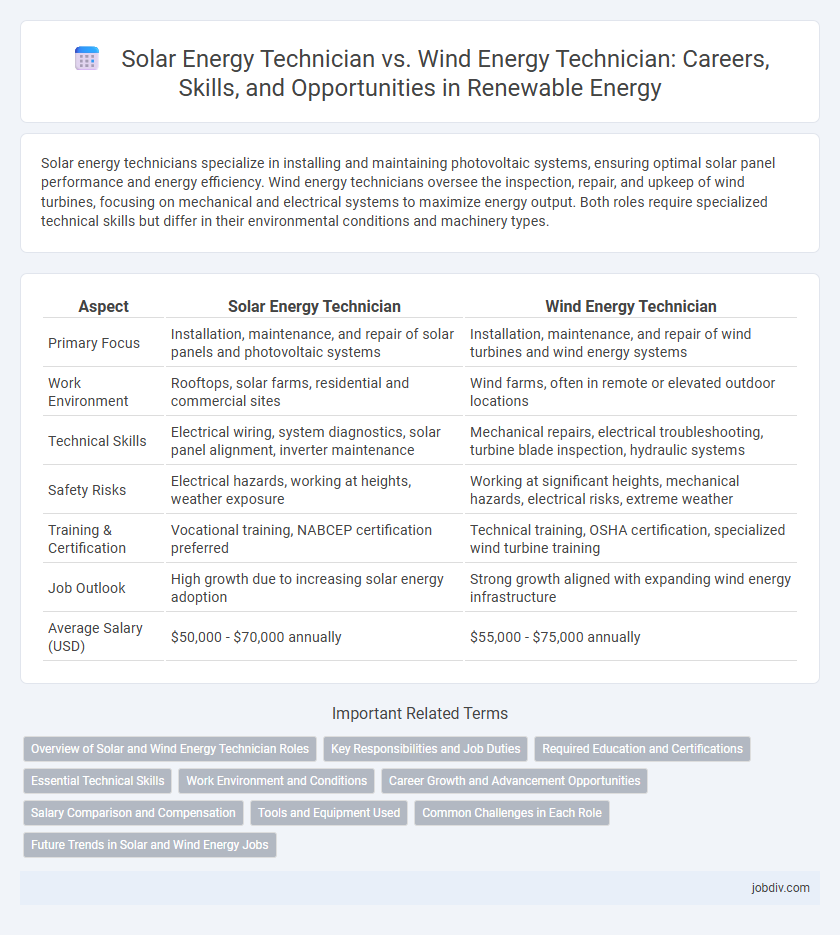Solar energy technicians specialize in installing and maintaining photovoltaic systems, ensuring optimal solar panel performance and energy efficiency. Wind energy technicians oversee the inspection, repair, and upkeep of wind turbines, focusing on mechanical and electrical systems to maximize energy output. Both roles require specialized technical skills but differ in their environmental conditions and machinery types.
Table of Comparison
| Aspect | Solar Energy Technician | Wind Energy Technician |
|---|---|---|
| Primary Focus | Installation, maintenance, and repair of solar panels and photovoltaic systems | Installation, maintenance, and repair of wind turbines and wind energy systems |
| Work Environment | Rooftops, solar farms, residential and commercial sites | Wind farms, often in remote or elevated outdoor locations |
| Technical Skills | Electrical wiring, system diagnostics, solar panel alignment, inverter maintenance | Mechanical repairs, electrical troubleshooting, turbine blade inspection, hydraulic systems |
| Safety Risks | Electrical hazards, working at heights, weather exposure | Working at significant heights, mechanical hazards, electrical risks, extreme weather |
| Training & Certification | Vocational training, NABCEP certification preferred | Technical training, OSHA certification, specialized wind turbine training |
| Job Outlook | High growth due to increasing solar energy adoption | Strong growth aligned with expanding wind energy infrastructure |
| Average Salary (USD) | $50,000 - $70,000 annually | $55,000 - $75,000 annually |
Overview of Solar and Wind Energy Technician Roles
Solar energy technicians specialize in installing, maintaining, and repairing photovoltaic systems that convert sunlight into electricity, ensuring optimal energy output and system efficiency. Wind energy technicians focus on the inspection, maintenance, and repair of wind turbines, including mechanical, electrical, and hydraulic components, to maximize wind energy generation. Both roles require technical expertise, safety knowledge, and problem-solving skills, but solar technicians often work at ground level whereas wind technicians perform high-altitude maintenance on turbines.
Key Responsibilities and Job Duties
Solar Energy Technicians primarily focus on installing, maintaining, and repairing photovoltaic solar panel systems to ensure optimal energy production. Wind Energy Technicians are responsible for inspecting, testing, and maintaining wind turbines, including mechanical, electrical, and hydraulic components to maximize efficiency. Both roles require troubleshooting and system diagnostics, but Solar Technicians work mainly with rooftop or ground-mounted panels, while Wind Technicians handle large-scale turbine machinery often located in remote areas.
Required Education and Certifications
Solar Energy Technicians typically need a high school diploma along with specialized training or certification programs in photovoltaic systems, often obtained through technical schools or community colleges. Wind Energy Technicians usually require a similar educational background but place greater emphasis on certifications like the Global Wind Organisation (GWO) safety training and specialized knowledge in turbine technology and maintenance. Both roles benefit from certifications such as OSHA safety training and EPA Universal Certification to enhance job prospects and ensure compliance with industry standards.
Essential Technical Skills
Solar Energy Technicians require proficiency in photovoltaic system installation, electrical wiring, and troubleshooting solar panels to ensure optimal energy conversion and efficiency. Wind Energy Technicians focus on mechanical systems expertise, including turbine blade repair, hydraulic systems maintenance, and electrical generator troubleshooting to maximize wind farm output. Both roles demand strong knowledge of safety protocols, electrical systems, and diagnostic tools within renewable energy technologies.
Work Environment and Conditions
Solar energy technicians primarily work outdoors installing and maintaining photovoltaic panels, often exposed to variable weather conditions such as heat, sun, and occasional rain. Wind energy technicians climb turbines and perform repairs at significant heights, facing challenges related to wind, cold temperatures, and remote locations. Both professions require physical stamina and adherence to strict safety protocols to manage environmental risks effectively.
Career Growth and Advancement Opportunities
Solar Energy Technicians benefit from a rapidly expanding industry with projected job growth of 17% over the next decade, driven by increasing solar panel installations and advancements in photovoltaic technology. Wind Energy Technicians face a similarly robust outlook, with a 68% employment growth rate fueled by offshore wind projects and rising demand for renewable energy infrastructure. Career advancement for both roles often involves specialization in system design, project management, or transitioning into engineering roles that leverage emerging technologies in renewable energy.
Salary Comparison and Compensation
Solar Energy Technicians earn a median annual salary of approximately $46,000, with compensation influenced by experience, location, and certifications, while Wind Energy Technicians typically receive a higher median pay near $56,000, reflecting specialized skills and the industry's demand. Both roles offer benefits such as health insurance and retirement plans, but wind energy positions often include additional incentives like hazard pay or overtime due to the challenging work environment. Salary growth in both fields aligns with the expanding renewable energy sector, with wind technicians generally experiencing steeper increases tied to project complexity and technological advancements.
Tools and Equipment Used
Solar Energy Technicians primarily use tools such as multimeters, solar pathfinders, and thermal imaging cameras to install, maintain, and troubleshoot photovoltaic panels. Wind Energy Technicians rely on equipment including climb assist devices, hydraulic torque wrenches, and anemometers for inspecting and repairing turbine blades and mechanical components. Both professions require safety gear like harnesses and hard hats, but their specialized tools reflect the distinct technologies of solar panels versus wind turbines.
Common Challenges in Each Role
Solar energy technicians often face challenges related to harsh weather conditions and the need for precise installation and maintenance of photovoltaic panels. Wind energy technicians commonly encounter difficulties with working at great heights and performing repairs in unpredictable, high-wind environments. Both roles require rigorous safety protocols and continuous adaptation to rapidly evolving technology within the renewable energy sector.
Future Trends in Solar and Wind Energy Jobs
Solar energy technician roles are rapidly expanding due to decreasing photovoltaic costs and increased government incentives aimed at renewable energy adoption. Wind energy technician positions are also projected to grow, driven by advancements in turbine technology and offshore wind farm developments. Both careers offer strong job market potential, with solar energy possibly leading due to its broader residential and commercial applications.
Solar Energy Technician vs Wind Energy Technician Infographic

 jobdiv.com
jobdiv.com